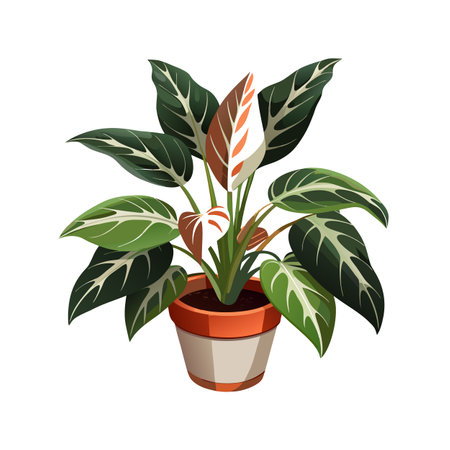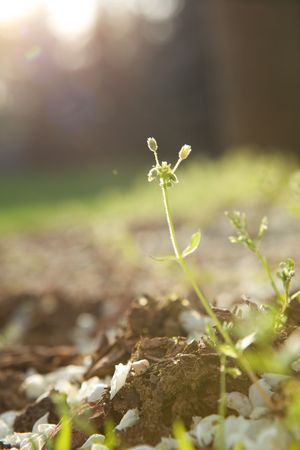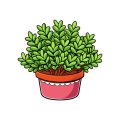1. What Are Fusarium Wilt and Verticillium Wilt?
Fusarium wilt and Verticillium wilt are two common soil-borne fungal diseases that affect a wide variety of plants in American gardens and landscapes. These diseases can cause serious damage to vegetables, flowers, shrubs, and even trees by invading the plant’s vascular system—the part responsible for transporting water and nutrients. Once inside the plant, these fungi block the flow of water, leading to wilting, yellowing leaves, stunted growth, and eventually plant death.
How Do These Fungi Develop?
Both Fusarium and Verticillium fungi live in the soil and can survive there for many years, even without a host plant. They typically enter plants through the roots, especially when the roots are damaged or stressed. Warm soil temperatures tend to favor Fusarium wilt, while Verticillium wilt is more active in cooler conditions. Once inside the plant, the fungus spreads quickly through the vascular tissue.
Plants Commonly Affected in U.S. Gardens
These fungal diseases can impact a broad range of popular garden plants. Heres a quick look at some common hosts:
| Plant Type | Fusarium Wilt | Verticillium Wilt |
|---|---|---|
| Tomatoes | Yes | Yes |
| Peppers | Yes | No |
| Eggplants | Yes | Yes |
| Potatoes | No | Yes |
| Shrubs (e.g., smoke bush, lilac) | No | Yes |
| Trees (e.g., maple, ash) | No | Yes |
Important Note:
The symptoms of both diseases can look similar—wilting during the heat of the day that may seem to recover at night—but over time the damage becomes irreversible. If youre noticing sudden or unexplained decline in your garden plants despite regular care, it might be time to consider testing your soil for these pathogens.
2. Recognizing the Symptoms
Fusarium wilt and Verticillium wilt are both soil-borne fungal diseases that can cause serious damage to a wide range of plants, including tomatoes, peppers, potatoes, and many ornamental species. Spotting these diseases early is key to managing their spread and minimizing plant loss. While they share some similarities, there are distinct visual clues that can help you tell them apart and take action quickly.
Wilting Patterns
One of the first signs gardeners often notice is wilting. However, not all wilting is created equal. With Fusarium wilt, youll typically see one side or one branch of the plant begin to wilt while the rest appears healthy—at least at first. Verticillium wilt, on the other hand, may cause more generalized wilting across the plant but often less severe in early stages.
Comparison of Wilting Patterns
| Disease | Wilting Pattern |
|---|---|
| Fusarium Wilt | Asymmetrical wilting (one side or branch) |
| Verticillium Wilt | More uniform wilting, sometimes affecting lower leaves first |
Leaf Discoloration
Leaf color changes can offer another clue. With Fusarium wilt, leaves may turn yellow starting from the bottom of the plant and progress upward. In contrast, Verticillium wilt often causes a mottled yellowing or browning between leaf veins, giving a scorched appearance.
Leaf Discoloration Signs
| Disease | Leaf Symptoms |
|---|---|
| Fusarium Wilt | Yellowing starts from lower leaves; moves upward; entire leaf may collapse |
| Verticillium Wilt | Mottled yellowing or browning between veins; leaf edges may curl or dry out |
Internal Stem Signs
If youre still unsure which disease youre dealing with, cutting open a stem can reveal more information. For Fusarium wilt, look for dark brown streaks inside the stem running vertically along the vascular tissue. Verticillium wilt also causes discoloration inside stems but tends to be lighter brown or olive-colored and less defined than Fusarium.
Stem Discoloration Comparison
| Disease | Internal Stem Coloration |
|---|---|
| Fusarium Wilt | Dark brown streaks along vascular system (xylem) |
| Verticillium Wilt | Lighter brown or olive-green discoloration; less sharply defined than Fusarium streaks |
When to Investigate Further
If you notice any of these symptoms—especially in combination—it’s a good idea to further investigate by checking multiple parts of the plant and considering lab testing for confirmation. Early detection can help you make informed decisions about removing infected plants or rotating crops to minimize future outbreaks.
Tip:
Avoid confusing these symptoms with simple water stress or nutrient deficiencies. Always check soil moisture levels and fertilization before jumping to conclusions about disease.
By learning to recognize these key signs, home gardeners and small-scale growers alike can become better equipped to manage Fusarium and Verticillium wilts before they take hold in your garden beds.

3. Understanding How These Fungi Spread
Fusarium wilt and Verticillium wilt are two serious soil-borne fungal diseases that can cause major damage to home gardens, farms, and landscapes across the United States. To manage or prevent these diseases effectively, it’s important to understand how they spread. These fungi dont just sit in one place—they move through soil, water, contaminated tools, and infected plant material.
How the Fungi Travel
Both Fusarium and Verticillium fungi produce spores that can survive in the soil for many years, even without a host plant. These spores are tough and can be moved in several ways:
Common Ways Fusarium and Verticillium Spread
| Pathway | Description | Tips to Prevent Spread |
|---|---|---|
| Soil Movement | Spores cling to soil particles that can be moved by wind, water runoff, or human activity. | Avoid moving soil between garden areas; use raised beds with clean soil. |
| Water | Irrigation systems and rainwater can carry spores from infected areas to healthy plants. | Use drip irrigation to minimize splash; ensure proper drainage. |
| Contaminated Tools | Pruners, shovels, or tillers used on infected plants can carry spores to other areas. | Disinfect tools with a bleach solution (1 part bleach to 9 parts water). |
| Infected Plant Material | Spores can live in plant debris or transplants brought into the garden. | Only buy disease-free plants; remove and destroy infected material immediately. |
| Compost and Mulch | If infected plant parts are composted improperly, spores may survive and reinfect the garden. | Avoid composting diseased plants unless using high-heat methods (over 140°F). |
U.S. Climate Factors That Influence Outbreaks
The climate plays a big role in how active these fungi are. In warmer southern states like Florida or Texas, Fusarium tends to thrive due to higher soil temperatures. Verticillium is more common in cooler regions such as the Pacific Northwest or the northern Midwest. Moisture levels also matter—overwatering or heavy rainfall creates ideal conditions for these fungi to spread quickly.
Climate Impact Overview
| Region | Typical Conditions | Main Concern |
|---|---|---|
| Southeast U.S. | Hot & humid summers; mild winters | Fusarium Wilt outbreaks in tomatoes, bananas, cotton |
| Pacific Northwest | Mild temps; high rainfall in spring/fall | Verticillium Wilt in maples, potatoes, strawberries |
| Southwest U.S. | Dry heat; occasional monsoons | Sporadic outbreaks depending on irrigation practices |
| Northern Midwest & Northeast | Cooler growing seasons; moderate rainfall | Verticillium Wilt common in trees and vegetables like eggplant and pepper |
The Role of Crop Rotation and Plant Choice
Certain crops are more vulnerable than others. For example, tomatoes, eggplants, and peppers are very susceptible to both Fusarium and Verticillium wilts. If you grow these often in the same spot each year, your risk of disease increases. Rotating crops with less susceptible plants like corn or beans can help reduce fungal spore buildup over time.
Tip:
If youve had wilt issues before, consider planting resistant varieties labeled “VFN” (resistant to Verticillium, Fusarium, and Nematodes) available at most U.S. nurseries and seed catalogs.
Sanitation is Key!
A clean garden is a healthy garden. Simple steps like cleaning your tools regularly, removing plant debris at the end of the season, and not walking through wet soil when its been recently watered can go a long way in keeping these fungal threats under control.
4. Diagnosis and Verification
Identifying whether your plants are suffering from Fusarium wilt or Verticillium wilt is a critical first step before taking any action. Both diseases share similar symptoms—such as yellowing leaves, wilting, and stunted growth—but require different management strategies. Misdiagnosis can lead to wasted time and money, so getting it right matters.
Why Accurate Diagnosis Matters
Because these fungal diseases live in the soil and affect plant vascular systems, their symptoms often mimic other problems like drought stress or nutrient deficiencies. That’s why visual inspection alone may not be enough. A proper diagnosis ensures you’re treating the correct issue and helps prevent unnecessary pesticide use.
Common Symptoms of Fusarium vs. Verticillium Wilt
| Symptom | Fusarium Wilt | Verticillium Wilt |
|---|---|---|
| Leaf Yellowing | Often starts on one side of the plant | Usually more uniform across plant |
| Vascular Discoloration | Dark brown streaks inside stem base | Lighter brown streaks, higher up in stem |
| Wilting Pattern | More severe during hot weather | May persist even in cooler temperatures |
| Plant Death Speed | Rapid in warm conditions | Slower progression overall |
Testing Methods for Confirmation
1. Local Extension Services
Your local Cooperative Extension office is one of the best resources for plant disease diagnostics. Many offer diagnostic services or can guide you on how to collect and send samples to a lab. These offices are staffed with experts who understand regional issues, making them especially helpful for gardeners and farmers alike.
2. Laboratory Diagnostics
If symptoms strongly suggest either Fusarium or Verticillium wilt, sending samples to a certified plant pathology lab is your most reliable option. These labs use techniques like culturing fungi from plant tissue or DNA-based tests (PCR) to confirm the presence of specific pathogens.
3. At-Home Observation Tips (Not a Substitute)
You can do some preliminary checks at home by cutting open affected stems and looking for discoloration in the vascular tissue. However, this should only be used as an initial step—not a replacement—for professional testing.
What to Send for Testing?
A good sample increases your chances of an accurate diagnosis. Heres what to include:
- A whole plant or several branches showing early and advanced symptoms
- A portion of roots with some surrounding soil (if possible)
- A completed submission form if required by the lab or extension office
- Description of growing conditions and recent weather patterns
5. Management and Prevention Strategies
Managing Fusarium wilt and Verticillium wilt in your garden takes a combination of proactive care, smart planting choices, and soil management. These fungal diseases are tough to get rid of once they’re in the soil, so prevention is key. Here are practical strategies that American gardeners can follow to keep their plants healthy and reduce the risk of infection.
Best Practices for Dealing with Infected Plants
- Remove and Destroy: As soon as you spot signs of infection—wilting, yellowing leaves, or browning stems—remove the entire plant, including roots. Do not compost infected material; dispose of it in the trash to prevent spreading spores.
- Disinfect Tools: Clean pruners, shovels, and other tools with a bleach solution (1 part bleach to 9 parts water) after working with infected plants.
- Avoid Replanting in Same Spot: Don’t plant susceptible crops in the same location where an infected plant was removed for at least 4–6 years.
Soil Remediation Techniques
Since these wilts live in the soil, managing the soil environment is crucial. Here are some techniques to reduce fungal spore levels:
| Technique | Description | Best Time to Apply |
|---|---|---|
| Solarization | Cover moist soil with clear plastic during hot months to “cook” pathogens using sunlight. | Mid to late summer for at least 4–6 weeks |
| Crop Rotation | Rotate crops with non-host species like corn or grasses to interrupt disease cycles. | Every growing season |
| Add Organic Matter | Add compost to encourage beneficial microbes that compete with harmful fungi. | Spring or fall before planting |
Choosing Resistant Plant Varieties
Selecting disease-resistant varieties is one of the easiest ways to avoid problems altogether. Many seed catalogs and plant tags include resistance codes like “VF” (resistant to Verticillium and Fusarium).
Examples of Resistant Varieties Common in U.S. Gardens:
- Tomatoes: ‘Celebrity’, ‘Better Boy’, ‘Roma VF’
- Peppers: ‘California Wonder VF’, ‘Revolution’
- Eggplants: ‘Black Beauty VF’, ‘Epic’
- Lettuce: Look for varieties labeled as “Verticillium-resistant” in seed catalogs
Long-Term Cultural Practices for Healthy Soil
Cultural practices can make your garden less welcoming to harmful fungi over time:
- Avoid Overwatering: Wet, poorly-drained soils encourage fungal growth. Water deeply but infrequently, and ensure proper drainage.
- Diversify Your Garden: A variety of plants means a lower chance of widespread infection from host-specific fungi.
- Add Mulch: Organic mulch helps retain moisture, regulate temperature, and suppress weeds without splashing soil onto plants.
- Sterilize Seedlings: Start seeds in sterile potting mix or purchase disease-free transplants from reputable nurseries.
By following these strategies, gardeners across the U.S. can better manage Fusarium wilt and Verticillium wilt while promoting long-term garden health.
6. Organic and Chemical Treatment Options
Fusarium wilt and Verticillium wilt are two tough soil-borne fungal diseases that can be hard to manage once they’re established in your garden or farm. While prevention is always the best strategy, there are treatment options—both organic and chemical—that can help reduce their impact. In the United States, the choice of products must follow EPA guidelines and state regulations. Heres a simple breakdown of whats available, legal, and effective.
Organic Treatment Options
For gardeners looking to stay eco-friendly, several organic methods can help suppress or slow down the spread of these fungal pathogens.
Biological Fungicides
These products contain beneficial microbes that compete with or inhibit disease-causing fungi in the soil.
| Product Name | Active Ingredient | Use Instructions | Availability |
|---|---|---|---|
| Serenade Garden | Bacillus subtilis | Apply as foliar spray or soil drench weekly | Available at most garden centers in the U.S. |
| RootShield | Trichoderma harzianum | Mix into soil before planting or apply as a drench | Online and commercial suppliers |
Compost Teas and Soil Amendments
Well-prepared compost teas can boost microbial activity in the soil, creating a less favorable environment for harmful fungi. Add organic matter like aged compost to improve drainage and support beneficial microbes.
Chemical Treatment Options
Chemical fungicides may offer more immediate results but should be used carefully to avoid harming beneficial organisms and polluting waterways. Always follow label instructions and check if the product is registered for use against Fusarium or Verticillium in your state.
Commonly Used Fungicides in the U.S.
| Product Name | Active Ingredient | Labeled Use Against Fusarium/Verticillium? | Notes |
|---|---|---|---|
| Clearys 3336F | Thiophanate-methyl | Yes (limited efficacy) | Mainly used on turf; limited use on vegetables |
| Luna Sensation | Fluopyram + Trifloxystrobin | No direct label but may suppress symptoms | Mainly labeled for fruit crops; consult local extension service before use |
Integrated Approach Tips
- Rotate crops: Avoid planting susceptible crops in the same spot for at least 3–5 years.
- Avoid overwatering: Excess moisture promotes fungal growth.
- Select resistant varieties: Many seed companies offer Fusarium- or Verticillium-resistant cultivars.
- Sterilize tools: Prevent cross-contamination between healthy and infected plants.
Know Before You Spray
If youre considering chemical treatments, check with your local Cooperative Extension Office or refer to the National Pesticide Information Center (NPIC) to ensure compliance with state-specific laws. Not all fungicides are permitted for residential use, and some may require applicator licenses for agricultural settings.
Tackling Fusarium and Verticillium wilts requires patience and persistence. Combining organic strategies with carefully selected chemical treatments gives you the best chance to protect your plants while staying environmentally responsible.


